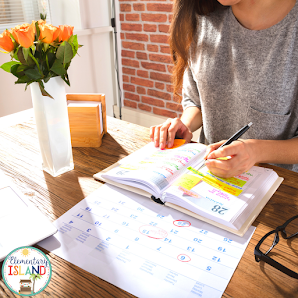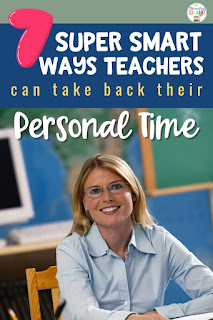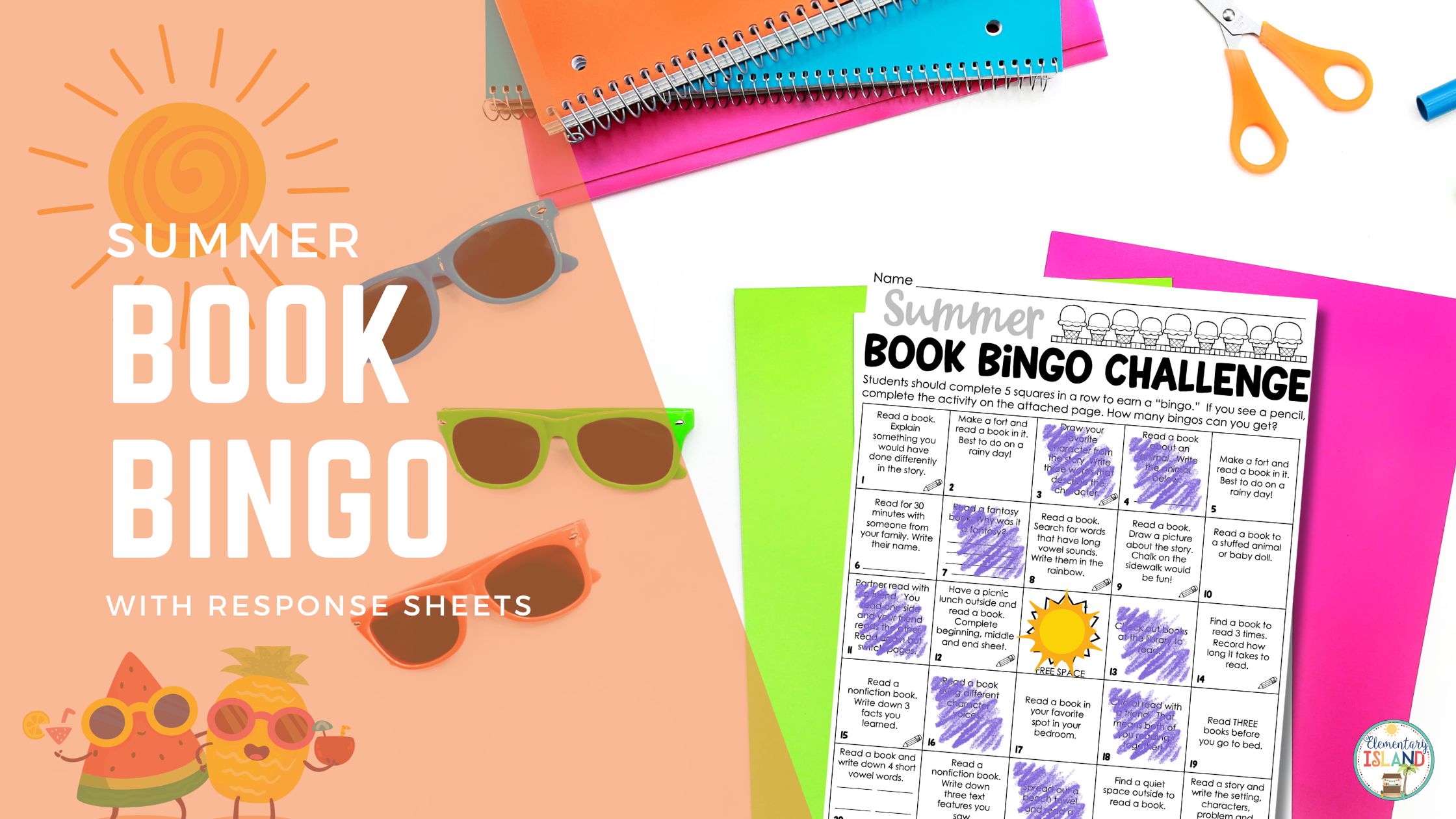We all know how hard it is to fit any sort of personal time into our day, and when we do, we oftentimes feel guilty about it. How many times have you wished for more time in your day so you could get more done? I hear you, busy teacher! I’m here to tell you that it is absolutely possible to take back some of your important personal time AND still be an amazing teacher. With a few clever and unbelievably easy adjustments to your schedule, you will be able to take back some of your personal time. These ideas will also help you feel less stressed and more organized. A win-win in my book! Here are 7 ways to take back your time!
1. Schedule Everything
A good schedule is a teacher’s best friend. Depending on what works best for you, you can make a monthly, weekly, or daily schedule to keep track of everything you have going on in your personal and school life.
Consider taking a week to track your activities. Be diligent and write down everything you do during the week from lesson planning to yoga classes to family activities. This will give you a really good idea of what needs to go on your daily schedule.
Once you start filling your schedule, color code activities depending on their category. Use one color for personal or family activities, and a different color for school-related activities. When you look at your schedule you can quickly see what you have going on. It also makes it really easy to see where your time is going.
Now it’s time to make some changes. For example, if you see that you spend hours grading on the weekend, but not very much time grading during the week, see if you can make an adjustment. Maybe you can take those hours from the weekend and spread them over a few days during the week. This will really open up your free time and help you feel like you can really relax during the weekend. Make a goal of having some personal time color on each and every page!
Making a daily schedule the night before also helps you to mentally prepare for the day ahead. During the day, post your schedule somewhere where you will see it frequently throughout the day. Maybe on your computer with a sticky note, write it on your whiteboard, or even use dry-erase or vis-a-vis to write it on your classroom window. Be creative!
2. Organize
Organizing your space will help you feel less stressed. It will also save you time finding your teaching resources when you have everything in a dedicated space.
Organizing your classroom might seem like a daunting task that takes hours of your free time, but that doesn’t have to be the case. Just like you are making a schedule of daily tasks, add 10-15 minutes every day to take on a small organization task.
You might take 15 minutes before class starts one day to organize and label the headphones. You can put them in plastic baggies with numbers, hang them on hooks or pegs with tape tab numbers, or even use 3M hooks to hang them beside your computers. This simple task can save you valuable time when your students are getting ready to do a computer-based activity and need your help untangling or finding the headphones. Now, you’ve saved yourself 5-10 minutes each day! Which is 25-50 minutes a week!
If you are someone who wants to organize at the beginning or end of the year when you don’t have students in your classroom, make sure to do some preplanning to get the most out of it. Bring in some plastic bins or use trash bags to sort supplies into categories.
Ways to organize your classroom supplies and resources could include:
- Use bins to organize your resources by season or month. This is so helpful because you can just pull out the bin for the month or season and everything you need from bulletin board designs, lesson plans, worksheets, classroom decorations, and seasonal activities will all be in one place.
- Create “keep it” and “toss it” bins. Every teacher knows they have supplies laying around that they aren’t sure they have used in a year or more. A good rule of thumb is if you haven’t used the resource, supply, or activity in two consecutive years… TOSS IT. Getting rid of unnecessary items in your classroom will give you much-needed space to store the things you use often making them easily accessible. Toss it doesn’t mean it has to go into the garbage, but you do need to get it out of your classroom. Share with a teacher friend or donate to a local charity if it is something that still has some life in it.
- Use your space in creative ways to help you store your resources close to where you will be using them. For example, if you consistently start your literacy activities on the carpet in the front of the room, store all of your literacy materials near that area as well. Use milk crates for extra shelving or get an over-the-door organizer to keep everything handy.
Just like Rome wasn’t built in a day, you don’t need to take on organizing all in one day either. Take as much time as you need, even if it’s the entire school year to get yourself organized. Just think . . . a few minutes each day this year will lead to so much saved time in the future. Once you find what works for you, it will become second nature year after year.
3. Keep A Routine
I know it can seem like every day is a hectic mess when you are a teacher trying to balance your personal and professional time. Making a routine for yourself can help you feel more balanced. You love your students and want the best for them, but having a burned-out teacher is no fun for anyone in the classroom.
Be sure to set your routine and stick to it as much as possible throughout the week. If your routine is to stay at school an extra 30 minutes to wrap up the day and prepare for the next, then stick to it.
Keeping a routine goes hand-in-hand with creating a schedule. When you have a daily routine in place, you will balance your personal and professional time in a more meaningful way.
Having a routine for your teaching time is also important. Plan a morning routine that your students can do independently. This will free you up to take care of all the administrative tasks that must be done. Always let your students complete tasks they can do. With some clear classroom procedures in place, your mornings can be smooth and efficient!
Your students can be working on morning work while you take attendance and submit the lunch counts. I love to use these
number of the day activities above! Students get to work immediately with very little instruction from me because they have repetitive activities each month. Make time at the beginning of the year to teach the morning procedures. A consistent morning routine will have them working on their own in no time!
👉🏼 Click
HERE to check out the themed Number of the Day activities that grow in difficulty
Don’t be afraid to make time for yourself part of your daily schedule whether that’s at the beginning of the day with a cup of coffee before everyone else wakes up, or some quiet time to yourself after you arrive home. Making personal time a part of your daily routine is so important for your physical, mental, and emotional health and you shouldn’t feel guilty about it. If this is something you struggle with, go back and read that last sentence one more time.
4. Grade Smarter Not Longer
Don’t spend all of your precious free time grading assignments. First, know that not every assignment needs to be graded! Yep, you read that right. It is okay to simply do a quick check or not grade an assignment at all.
For those that you do grade, build grading time into your schedule. Use your newly created daily schedule, organizational skills, and routine to plan specific amounts of time in your day or week to focus on grading. Make a list of the assignments you need to grade and organize them in folders or binders for easy access.
Ways to make grading more efficient include:
- Set a timer. Set aside a specific amount of time for grading every day or week and stick to it!
- Organize the work you have to grade in folders or binders to make it easy to find and hand back once graded.
- Make a list of teacher comments to refer to while grading.
- Put up a Do Not Disturb sign on your classroom door to keep teacher friends from distracting you during your grading time.
- Try some peer-to-peer grading. Give your students the opportunity to go over their answers with a peer. Giving and getting feedback from a peer builds confidence and class community.
Getting creative with your grading processes can really save you some precious time! Make sure to set realistic deadlines for grading and make these clear for students AND parents. Send out your grading policy early in the year and make it a part of your routine.
5. Just Say No!
As a teacher, there are demands on your time coming at you from all directions. It’s really easy for your extra time in the day to get quickly filled by helping others. While that is not a bad thing, it doesn’t leave much room for taking care of you.
Be intentional in what you choose to say “yes” to. Saying no to an extra committee, lunch in the teacher’s lounge, or making cookies for the bake sale does not make you a bad person. In fact, it makes you a better person because you are making time for yourself.
When you do say yes, make sure to schedule that time on your calendar. There’s nothing worse than double scheduling and your new commitments causing you to get behind in your other tasks. This just starts the cycle of stress that we are trying to avoid.
If you find saying no difficult, you are not alone. Here are a couple suggestions that might help:
- Say no during your busy times like the first and last month of school.
- Set a limit on how many times you will say “yes.” Maybe once a month or twice a month will work for you. Then stick to it!
6. Don’t Be Afraid To Delegate
Delegate is not a bad word! In fact, when used correctly delegating can help you and others. Don’t be afraid to delegate some of your tasks to those that can or want to help. Whether you have a classroom assistant, parent volunteers, or older students, think of some tasks you would normally spend your precious time on that someone else could do.
Some tasks you can delegate could include:
- Organizing worksheets or resources for center activities
- Grading spelling tests, or small assignments
- Printing or copying resources
- Putting together homework folders
- Organizing classroom supplies
- Wiping down tables and chairs with disinfectant
- Working with groups of students on extra reading, spelling, or math practice
While these are necessary tasks, they are also tasks that don’t require a teaching degree or education background. This makes them perfect for delegating.
As you look to delegate tasks, think about who could complete the task. Some simple and strategic delegating can make a big difference!
If there is something your students can do – let them do it! Organize your classroom in such a way that they aren’t relying on you to get basic supplies and manipulatives. Teach them how to self-check activities and build in procedures that make them independent learners. Take any variety of classroom activities and turn it into a class job and you will have students begging to do them! Remember that with a little instruction, even our young students can be very helpful in the classroom.
Have former students that want to come back and help? Great! Let them help with some small tasks. They would love to help organize supplies, pass out papers or even read with a younger student. And don’t forget about your parents! Many parents want to help but they just don’t know how. Have some tasks parents can help with at school, and also some they can do from home. Share these tasks during open hours or parent meetings and you’ll be surprised at how much help you can get.
Those tasks that do require an educational background are best left for your classroom assistant or paraprofessional. Take a few minutes each week to plan out what they can do in the classroom during their designated time. This planning will pay off as you delegate classroom tasks and are able to accomplish more when they are in your room. Not sure how to use them, just ask them what they enjoy doing. When you give them some ownership in the classroom they become a valuable part of your classroom community.
7. Use Tech Efficiently
Use technology to your advantage to help free up some of your time during the day. I’m not suggesting a ton of screen time by any means, but there is a way to use technology wisely to your advantage. With all of the new digital learning skills we have all had to acquire, it’s easy now more than ever to find digital educational opportunities for your students during the day.
An easy way to use technology to your advantage is to use digital activities students can do in small groups or with partners. You may not always have a 1:1 technology ratio in your classroom, so partnering up students is a great way to get more out of the devices you have. Since many digital activities are self-checking they make great practice activities while you are working with small groups.
There are also lots of educational tools and apps that use technology to do the heavy lifting for you! I really love
Quizizz for assessments and
Power Spelling. In fact, all of my assessments are now through these two programs. For daily classwork, I use
Google Forms to set-up assignments. Google will do the grading for you and send you a nice, neat spreadsheet with all the results.
Boom Learning is also another fun, engaging platform that students enjoy tremendously! The free version is wonderful for centers, but if you want some recording done with each students’ progress to help differentiate, the paid version is the route to go!
Using Boom Cards in the classroom is a great way for students to show their learning.
👉🏼 Click
HERE for some Boom Card decks you can use in your classroom
Some others that you might want to look into include ESGI for assessments and data,
Class Dojo for classroom management, and
Remind for parent communication. A quick Google search will help you find these and many, many more!
There are also many tech tools that can help you as a teacher. Save time when writing emails to parents by keeping a template in the draft folder. At the beginning of the year, add each parent’s email into your contact list. This saves you time all year long from having to find that email when you need it.
You can also save all your lesson planning on the computer so you don’t reinvent the wheel every year. As teachers, we know adaptations need to be made from year to year, but you will have the core basics that you will teach right in front of you! Here is a math example that I work off of for the year. As I schedule the activity in my lesson plans, I highlight so I know where I left off! Click on the picture for an enlargement.
Organize your teaching resources on your computer. Using skill or topic-based folders allows you to quickly find all the resources you already have regarding lesson planning. Rename files using a system that works for you. You might name files by the skill, topic, month, holiday or grading period when it will be used. You can also add identifying words like center, morning work, homework or assessment to help you quickly find what you need. And . . . don’t forget to use your computer search tool when you are looking for classroom activities. A simple search for ‘subtraction’ should reveal a variety of subtraction activities that you can use as you plan your lessons and centers.
Go Get Your Personal Time!
Now it’s time to start doing one or more of these things so you can take back your personal time! Give yourself permission to take care of yourself. You will be a better teacher, parent and friend when you take time to feed your soul. Making yourself a part of your daily routine will turn into a habit you will thank yourself for in the future.
Be sure to pin this to your favorite classroom Pinterest board so you can come back when you need to review these tips for taking back your personal time.




















